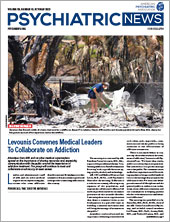In July experts in addiction psychiatry came to APA headquarters in Washington, D.C., to offer pointers on the use of medications for substance use disorders to attendees of APA’s first meeting of @theAPA Educational Series, “Addictions Update.”
APA President Petros Levounis M.D., M.A., kicked off the series with a discussion of how understanding of the neurobiology of substance use disorder (SUD) and behavioral addictions has come a long way since the 1980s, when addiction was recognized as a biopsychosocial illness. His presentation included a historical perspective of addiction and a discussion of a newer, more modern neurobiological framework that describes how addiction changes the circuitry of the brain.
“Before 1980 or so, people thought that addiction was essentially a moral failure and a weakness in that people could not resist the temptations of drugs and alcohol. But somewhere around 1980, science and medicine said ‘not so fast,’” Levounis said.
Levounis noted that 1980s-era descriptions of addiction as an illness recognized the importance of genetics and family history, as evidenced by the increased risk of alcohol use disorder (AUD) in people whose parents had AUD. Yet there remained the thinking that people who used substances did it only to get high or escape the world.
“Then the self-medication hypothesis came around and again we said ‘No, no, no, not so fast,’” Levounis said. “We saw that people also feel depressed and suffer from underlying, underappreciated, underdiagnosed, and undertreated conditions and they use the drugs in order to normalize.” In other words, some people use substances to get through their days, feel normal, or function, rather than experience euphoria.
“This is the patient who comes to my office and says ‘Doc, I save all week so I can go out on Friday night and buy as much cocaine as I can so I can feel at home,’” Levounis said.
“In 2023, we appreciate both sides of this. Don't let anybody tell you that it's all about getting high. Don’t let anybody tell you that it’s all about self-medication,” Levounis said. “Sometimes people do use [substances] to get high but there are a lot of other psychological reasons why people might start using substances. There is also a lot of back-and-forth, where people start using them to get high and then move on to self-medicating and vice versa.”
He added that there is yet another psychological reason people turn to substance use: Performance enhancement, such as using substances to enhance athletic or sexual performance or performance on the battlefield of college-entry examinations.
Levounis described how concepts of the neurobiology of addiction have evolved from a focus on the “war” between pleasure-reward pathways in the brain that have been hijacked by substance use and the frontal lobes, which are responsible for rational thinking.
He presented a new neurobiological framework described by the Director of the National Institute on Alcohol Abuse and Alcoholism George F. Koob, Ph.D., and the Director of the National Institute on Drug Abuse Nora Volkow, M.D., over the past few years. This framework accounts for how substance use can change neurotransmitters and the circuitry of the brain, particularly with respect to the emotional impact of withdrawal after a binge of intoxication. After intoxication, people who are vulnerable to developing SUD may experience a phenomenon that Koob calls “hyperkatifeia” in which they feel increased emotional pain and distress. They then turn to substance use to relieve their emotional pain, further changing the neurotransmitters and circuitry of the brain. The cycle consists of binge intoxication, which affects the basal ganglia, followed by hyperkatifeia, which involves the extended amygdala. Several factors affect hyperkatifeia, including genetics, epigenetics, childhood trauma, and psychiatric comorbidities. Hyperkatifeia gives rise to urgency and prompts preoccupation and anticipation in the prefrontal cortex as the person thinks about using substances again.
“This all points to the chronic nature of addiction that fuels use and relapse,” Levounis explained.
From Psychoanalysis to Motivational Interviewing
Levounis offered a historical overview of treatment for addiction, starting with psychoanalysis. “Well, that did not work out,” he said. “Part of the fearful [and inaccurate] thinking was that once you get addicted, there is no such thing as treatment.”
The second wave consisted of highly confrontational approaches like boot camps, an approach that Levounis said did more harm than good.
The third and current wave consists of medications, psychotherapy and counseling, and mutual help (help that is not supervised by a mental health professional, such as 12-step programs).
Levounis described how the relationship between psychiatrists and patients with SUD or other addiction disorders has changed.
“We used to say a horrible thing to our patients, which was ‘Come see me when you’re ready. I’ve got nothing to offer you unless you want to change,’” he said. “The reason for that was that we didn’t have the techniques to work with people who were not sure what they wanted to do.”
“Now there are evidence-based approaches such as motivational interviewing that successfully treat patients who don’t want to stop using substances or are highly ambivalent,” Levounis said. “Today, we even go a step farther. At Rutgers, we work with patients who refuse to come see us altogether. We bring in families and teach them how to use motivational interview principles at home until the patient is motivated enough to come to the office. Motivational interview combined with cognitive-behavioral therapy, medications that disrupt cravings, mutual help groups, and therapies that sharpen the person’s mindfulness give us a powerful toolbox for recovery and well-being.” ■
